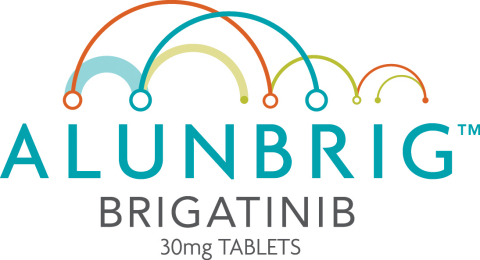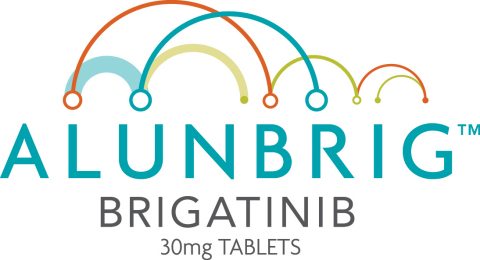CAMBRIDGE, Mass. & OSAKA, Japan--(BUSINESS WIRE)--Takeda Pharmaceutical Company Limited (TSE: 4502) today announced that ALUNBRIG™ (brigatinib) has received Accelerated Approval from the U.S. Food and Drug Administration (FDA) for the treatment of patients with anaplastic lymphoma kinase-positive (ALK+) metastatic non-small cell lung cancer (NSCLC) who have progressed on or are intolerant to crizotinib. This indication is approved under Accelerated Approval based on tumor response rate and duration of response. Continued approval for this indication may be contingent upon verification and description of clinical benefit in a confirmatory trial. ALUNBRIG, which previously received Breakthrough Therapy Designation from the FDA, is a once-daily oral therapy that may be taken with or without food.
“In recent years, small molecule ALK inhibitors have revolutionized the treatment options for those with advanced ALK+ non-small cell lung cancer. Nevertheless, there is still a need for additional ALK inhibitors like brigatinib (ALUNBRIG), which have a manageable safety profile and may address mechanisms of clinical resistance to crizotinib, including progression in the central nervous system,” said D. Ross Camidge, M.D., Ph.D., director of thoracic oncology at the University of Colorado. “The ALTA trial showed that brigatinib (ALUNBRIG) was highly effective post-crizotinib with the majority of patients who received 180 mg once daily with a seven-day lead in at 90 mg once daily achieving an overall response and a median duration of response greater than one year. Importantly, the extent of activity among those with brain metastases was also notable.”
“For patients with ALK+ metastatic NSCLC who have progressed on or are intolerant to crizotinib, who are facing the uncertainty of disease progression and the potentially devastating impact of brain metastases, the approval of ALUNBRIG offers a new hope,” said Bonnie Addario, founder and chair of the Addario Lung Cancer Foundation (ALCF).
“The rapid development of ALUNBRIG is a tribute to the dedication of many research scientists and clinicians who carefully designed and developed this new medicine to address unmet medical needs in the ALK+ NSCLC patient population. Most importantly, we would like to thank the patients and families who participated in the clinical trials,” said Andy Plump, M.D., Ph.D., Takeda Chief Medical and Scientific Officer.
“Today’s FDA approval of ALUNBRIG is an important milestone in the treatment of patients with ALK+ metastatic NSCLC who have progressed on or are intolerant to crizotinib,” said Christophe Bianchi, M.D., President, Takeda Oncology. “Takeda is committed to the continued development of ALUNBRIG around the globe and to bringing this important therapy to more patients in need.”
About the ALTA Trial
The FDA approval of ALUNBRIG was primarily based on results from the pivotal Phase 2 ALTA (ALK in Lung Cancer Trial of AP26113) trial of brigatinib in adults. This ongoing, two-arm, open-label, multicenter trial enrolled 222 patients with locally advanced or metastatic ALK+ NSCLC who had progressed on crizotinib. Patients received either 90 mg of ALUNBRIG once daily (n=112) or 180 mg once daily following a seven-day lead-in of 90 mg once daily (n=110). The major efficacy outcome measure was confirmed overall response rate (ORR) according to Response Evaluation Criteria in Solid Tumors (RECIST v1.1) as evaluated by an Independent Review Committee (IRC). Additional efficacy outcome measures included Investigator-assessed ORR, duration of response (DOR), intracranial ORR, and intracranial DOR.
The recommended dosing regimen for ALUNBRIG is 90 mg orally once daily for the first 7 days. If 90 mg is tolerated during the first 7 days, increase the dose to 180 mg orally once daily.
With a median follow-up of 8 months (range 0.1 - 20.2), results demonstrated that of the patients who received the recommended dosing regimen (90→180 mg), 53 percent achieved a confirmed overall response (OR) as assessed by IRC and 54 percent as assessed by Investigator. At the recommended dosing regimen, the median duration of response was 13.8 months as assessed by IRC and 11.1 months by Investigator assessment. Additionally, at the recommended dosing regimen, 67 percent of patients with measurable brain metastases (n=18) achieved a confirmed intracranial OR by IRC assessment.
Efficacy data are as follows:
|
ALTA Efficacy Results |
||||||
| Efficacy parameter | IRC Assessment | Investigator Assessment | ||||
|
90 mg once daily (N=112) |
90→180 mg
once daily (N=110) |
90 mg once (N=112) |
90→180 mg
once daily (N=110) |
|||
| Overall Response Rate (95% CI) | 48% (39-58) | 53% (43-62) | 45% (35-54) | 54% (44-63) | ||
| Complete Response, n (%) | 4 (3.6%) | 5 (4.5%) | 1 (0.9%) | 4 (3.6%) | ||
| Partial Response, n (%) | 50 (45%) | 53 (48%) | 49 (44%) | 55 (50%) | ||
|
Duration of Response, median in months
(95% CI) |
13.8
(7.4-NE) |
13.8
(9.3-NE) |
13.8
(5.6-13.8) |
11.1
(9.2-13.8) |
||
CI = Confidence Interval; NE = Not Estimable
IRC assessment of intracranial efficacy is shown below:
|
Intracranial Overall Response in Patients with Measurable Brain Metastases in ALTA |
||||
| Efficacy parameter | IRC Assessment | |||
|
90 mg once daily
(N=26) |
90→180 mg once daily
(N=18) |
|||
| Intracranial Overall Response Rate, (95 % CI) | 42% (23-63) | 67% (41-87) | ||
| Complete Response, n (%) | 2 (7.7%) | 0 | ||
| Partial Response, n (%) | 9 (35%) | 12 (67%) | ||
|
Duration of Intracranial Response, median (months)
(range) |
NE
(1.9+ - 9.2+) |
5.6
(1.9+ - 9.2+) |
||
CI = Confidence Interval; NE = Not Estimable
Among the 23 patients who exhibited an intracranial response, 78% of patients in the 90 mg arm and 68% of patients in the 90→180 mg group maintained a response for at least four months.
The warnings and precautions for ALUNBRIG are: interstitial lung disease (ILD)/pneumonitis, hypertension, bradycardia, visual disturbance, creatine phosphokinase (CPK) elevation, pancreatic enzyme elevation, hyperglycemia and embryo-fetal toxicity.
Serious adverse reactions occurred in 38% of patients in the 90 mg group and 40% of patients in the 90→180 mg group. The most common serious adverse reactions were pneumonia (5.5% overall, 3.7% in the 90 mg group, and 7.3% in the 90→180 mg group) and ILD/pneumonitis (4.6% overall, 1.8% in the 90 mg group and 7.3% in the 90→180 mg group). Fatal adverse reactions occurred in 3.7% of patients and consisted of pneumonia (2 patients), sudden death, dyspnea, respiratory failure, pulmonary embolism, bacterial meningitis and urosepsis (1 patient each).
At the recommended dosing regimen, the most common adverse reactions (≥25%) with ALUNBRIG were nausea, diarrhea, fatigue, cough, and headache.
About ALK+ NSCLC
Non-small cell lung cancer (NSCLC) is the most common form of lung cancer, accounting for approximately 85 percent of the estimated 222,500 new cases of lung cancer diagnosed each year in the United States, according to the American Cancer Society. Genetic studies indicate that chromosomal rearrangements in anaplastic lymphoma kinase (ALK) are key drivers in a subset of NSCLC patients as well. Approximately two to eight percent of patients with NSCLC have a rearrangement in the ALK gene.
The central nervous system (CNS) is a frequent site for ALK+ NSCLC progression, with up to 70 percent of patients with ALK+ NSCLC who have been treated with a first-line ALK inhibitor facing brain metastases.
About ALUNBRIG™ (brigatinib)
ALUNBRIG is a targeted cancer medicine discovered by ARIAD Pharmaceuticals, Inc., which was acquired by Takeda in February 2017. ALUNBRIG received Breakthrough Therapy Designation from the FDA for the treatment of patients with ALK+ NSCLC whose tumors are resistant to crizotinib, and was granted Orphan Drug Designation by the FDA for the treatment of ALK+ NSCLC, ROS1+ and EGFR+ NSCLC. A Marketing Authorization Application (MAA) for ALUNBRIG was submitted to the European Medicines Agency (EMA) in February 2017.
The ALTA clinical development program further reinforces Takeda’s ongoing commitment to developing innovative therapies for people living with ALK+ NSCLC worldwide and the healthcare professionals who treat them. In addition to the ongoing Phase 1/2 and Phase 2 ALTA trial, brigatinib is also being studied in the Phase 3 ALTA 1L trial to assess its efficacy and safety in comparison to crizotinib in patients with locally advanced or metastatic ALK+ NSCLC who have not received prior treatment with an ALK inhibitor.
To learn more about ALUNBRIG, please visit www.ALUNBRIG.com or call A1Point: 1-844-A1POINT (1-844-217-6468).
For additional information on the brigatinib clinical trials, please visit www.clinicaltrials.gov.
IMPORTANT SAFETY INFORMATION
WARNINGS AND PRECAUTIONS
Interstitial Lung Disease
(ILD)/Pneumonitis: Severe, life-threatening, and fatal pulmonary
adverse reactions consistent with interstitial lung disease
(ILD)/pneumonitis have occurred with ALUNBRIG. In Trial ALTA (ALTA),
ILD/pneumonitis occurred in 3.7% of patients in the 90 mg group (90 mg
once daily) and 9.1% of patients in the 90→180 mg group (180 mg once
daily with 7-day lead-in at 90 mg once daily). Adverse reactions
consistent with possible ILD/pneumonitis occurred early (within 9 days
of initiation of ALUNBRIG; median onset was 2 days) in 6.4% of patients,
with Grade 3 to 4 reactions occurring in 2.7%. Monitor for new or
worsening respiratory symptoms (e.g., dyspnea, cough, etc.),
particularly during the first week of initiating ALUNBRIG. Withhold
ALUNBRIG in any patient with new or worsening respiratory symptoms, and
promptly evaluate for ILD/pneumonitis or other causes of respiratory
symptoms (e.g., pulmonary embolism, tumor progression, and infectious
pneumonia). For Grade 1 or 2 ILD/pneumonitis, either resume ALUNBRIG
with dose reduction after recovery to baseline or permanently
discontinue ALUNBRIG. Permanently discontinue ALUNBRIG for Grade 3 or 4
ILD/pneumonitis or recurrence of Grade 1 or 2 ILD/pneumonitis.
Hypertension: In ALTA, hypertension was reported in 11% of patients in the 90 mg group who received ALUNBRIG and 21% of patients in the 90→180 mg group. Grade 3 hypertension occurred in 5.9% of patients overall. Control blood pressure prior to treatment with ALUNBRIG. Monitor blood pressure after 2 weeks and at least monthly thereafter during treatment with ALUNBRIG. Withhold ALUNBRIG for Grade 3 hypertension despite optimal antihypertensive therapy. Upon resolution or improvement to Grade 1 severity, resume ALUNBRIG at a reduced dose. Consider permanent discontinuation of treatment with ALUNBRIG for Grade 4 hypertension or recurrence of Grade 3 hypertension. Use caution when administering ALUNBRIG in combination with antihypertensive agents that cause bradycardia.
Bradycardia: Bradycardia can occur with ALUNBRIG. In ALTA, heart rates less than 50 beats per minute (bpm) occurred in 5.7% of patients in the 90 mg group and 7.6% of patients in the 90→180 mg group. Grade 2 bradycardia occurred in 1 (0.9%) patient in the 90 mg group. Monitor heart rate and blood pressure during treatment with ALUNBRIG. Monitor patients more frequently if concomitant use of drug known to cause bradycardia cannot be avoided. For symptomatic bradycardia, withhold ALUNBRIG and review concomitant medications for those known to cause bradycardia. If a concomitant medication known to cause bradycardia is identified and discontinued or dose adjusted, resume ALUNBRIG at the same dose following resolution of symptomatic bradycardia; otherwise, reduce the dose of ALUNBRIG following resolution of symptomatic bradycardia. Discontinue ALUNBRIG for life-threatening bradycardia if no contributing concomitant medication is identified.
Visual Disturbance: In ALTA, adverse reactions leading to visual disturbance including blurred vision, diplopia, and reduced visual acuity, were reported in 7.3% of patients treated with ALUNBRIG in the 90 mg group and 10% of patients in the 90→180 mg group. Grade 3 macular edema and cataract occurred in one patient each in the 90→180 mg group. Advise patients to report any visual symptoms. Withhold ALUNBRIG and obtain an ophthalmologic evaluation in patients with new or worsening visual symptoms of Grade 2 or greater severity. Upon recovery of Grade 2 or Grade 3 visual disturbances to Grade 1 severity or baseline, resume ALUNBRIG at a reduced dose. Permanently discontinue treatment with ALUNBRIG for Grade 4 visual disturbances.
Creatine Phosphokinase (CPK) Elevation: In ALTA, creatine phosphokinase (CPK) elevation occurred in 27% of patients receiving ALUNBRIG in the 90 mg group and 48% of patients in the 90 mg→180 mg group. The incidence of Grade 3-4 CPK elevation was 2.8% in the 90 mg group and 12% in the 90→180 mg group. Dose reduction for CPK elevation occurred in 1.8% of patients in the 90 mg group and 4.5% in the 90→180 mg group. Advise patients to report any unexplained muscle pain, tenderness, or weakness. Monitor CPK levels during ALUNBRIG treatment. Withhold ALUNBRIG for Grade 3 or 4 CPK elevation. Upon resolution or recovery to Grade 1 or baseline, resume ALUNBRIG at the same dose or at a reduced dose.
Pancreatic Enzyme Elevation: In ALTA, amylase elevation occurred in 27% of patients in the 90 mg group and 39% of patients in the 90→180 mg group. Lipase elevations occurred in 21% of patients in the 90 mg group and 45% of patients in the 90→180 mg group. Grade 3 or 4 amylase elevation occurred in 3.7% of patients in the 90 mg group and 2.7% of patients in the 90→180 mg group. Grade 3 or 4 lipase elevation occurred in 4.6% of patients in the 90 mg group and 5.5% of patients in the 90→180 mg group. Monitor lipase and amylase during treatment with ALUNBRIG. Withhold ALUNBRIG for Grade 3 or 4 pancreatic enzyme elevation. Upon resolution or recovery to Grade 1 or baseline, resume ALUNBRIG at the same dose or at a reduced dose.
Hyperglycemia: In ALTA, 43% of patients who received ALUNBRIG experienced new or worsening hyperglycemia. Grade 3 hyperglycemia, based on laboratory assessment of serum fasting glucose levels, occurred in 3.7% of patients. Two of 20 (10%) patients with diabetes or glucose intolerance at baseline required initiation of insulin while receiving ALUNBRIG. Assess fasting serum glucose prior to initiation of ALUNBRIG and monitor periodically thereafter. Initiate or optimize anti-hyperglycemic medications as needed. If adequate hyperglycemic control cannot be achieved with optimal medical management, withhold ALUNBRIG until adequate hyperglycemic control is achieved and consider reducing the dose of ALUNBRIG or permanently discontinuing ALUNBRIG.
Embryo-Fetal Toxicity: Based on its mechanism of action and findings in animals, ALUNBRIG can cause fetal harm when administered to pregnant women. There are no clinical data on the use of ALUNBRIG in pregnant women. Advise pregnant women of the potential risk to a fetus. Advise females of reproductive potential to use effective non-hormonal contraception during treatment with ALUNBRIG and for at least 4 months following the final dose. Advise males with female partners of reproductive potential to use effective contraception during treatment and for at least 3 months after the last dose of ALUNBRIG.
ADVERSE REACTIONS
Serious adverse reactions occurred in 38%
of patients in the 90 mg group and 40% of patients in the 90→180 mg
group. The most common serious adverse reactions were pneumonia (5.5%
overall, 3.7% in the 90 mg group, and 7.3% in the 90→180 mg group) and
ILD/pneumonitis (4.6% overall, 1.8% in the 90 mg group and 7.3% in the
90→180 mg group). Fatal adverse reactions occurred in 3.7% of patients
and consisted of pneumonia (2 patients), sudden death, dyspnea,
respiratory failure, pulmonary embolism, bacterial meningitis and
urosepsis (1 patient each).
The most common adverse reactions (≥25%) in the 90 mg group were nausea (33%), fatigue (29%), headache (28%), and dyspnea (27%) and in the 90→180 mg group were nausea (40%), diarrhea (38%), fatigue (36%), cough (34%), and headache (27%).
DRUG INTERACTIONS
CYP3A Inhibitors:
Avoid concomitant use of ALUNBRIG with strong CYP3A inhibitors. Avoid
grapefruit or grapefruit juice as it may also increase plasma
concentrations of brigatinib. If concomitant use of a strong CYP3A
inhibitor is unavoidable, reduce the dose of ALUNBRIG.
CYP3A
Inducers: Avoid concomitant use of ALUNBRIG with strong CYP3A
inducers.
CYP3A Substrates: Coadministration
of ALUNBRIG with CYP3A substrates, including hormonal contraceptives,
can result in decreased concentrations and loss of efficacy of CYP3A
substrates.
USE IN SPECIFIC POPULATIONS
Pregnancy: ALUNBRIG can
cause fetal harm. Advise females of reproductive potential of the
potential risk to a fetus.
Lactation: Advise lactating women
not to breastfeed during treatment with ALUNBRIG and for 1 week
following the final dose.
Females and Males of Reproductive
Potential:
Contraception: Advise
females of reproductive potential to use effective non-hormonal
contraception during treatment with ALUNBRIG and for at least 4 months
after the final dose. Advise males with female partners of reproductive
potential to use effective contraception during treatment with ALUNBRIG
and for at least 3 months after the final dose.
Infertility:
ALUNBRIG may cause reduced fertility in males.
Pediatric Use:
The safety and efficacy of ALUNBRIG in pediatric patients have not been
established.
Geriatric Use: Clinical studies of ALUNBRIG did
not include sufficient numbers of patients aged 65 years and older to
determine whether they respond differently from younger patients. Of the
222 patients in ALTA, 19.4% were 65-74 years and 4.1% were 75 years or
older. No clinically relevant differences in safety or efficacy were
observed between patients ≥65 and younger patients.
Hepatic or
Renal Impairment: No dose adjustment is recommended for patients
with mild hepatic impairment or mild or moderate renal impairment. The
safety of ALUNBRIG in patients with moderate or severe hepatic
impairment or severe renal impairment has not been studied.
Please see the full Prescribing Information for ALUNBRIG at www.ALUNBRIG.com
About Takeda
Takeda Pharmaceutical Company Limited is a global, research and development-driven pharmaceutical company committed to bringing better health and a brighter future to patients by translating science into life-changing medicines. Takeda focuses its R&D efforts on oncology, gastroenterology and central nervous system therapeutic areas plus vaccines. Takeda conducts R&D both internally and with partners to stay at the leading edge of innovation. New innovative products, especially in oncology and gastroenterology, as well as our presence in Emerging Markets, fuel the growth of Takeda. More than 30,000 Takeda employees are committed to improving quality of life for patients, working with our partners in health care in more than 70 countries. For more information, visit http://www.takeda.com/news.
Additional information about Takeda is available through its corporate website, www.takeda.com, and additional information about Takeda Oncology, the brand for the global oncology business unit of Takeda Pharmaceutical Company Limited, is available through its website, www.takedaoncology.com.






